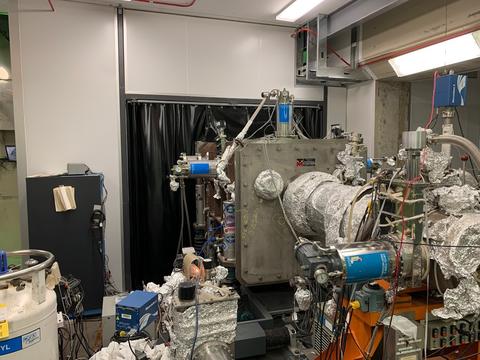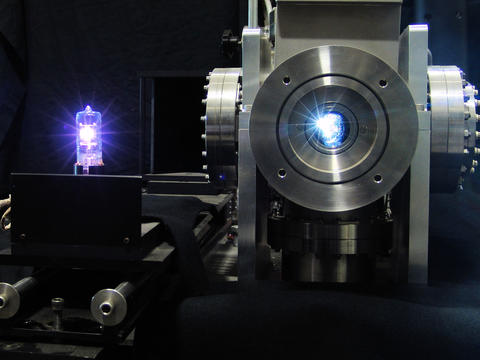Beamline 2: Absolute Source-Based Radiometry
Absolute source-based radiometry is founded in the traceability of a light source’s output to measurable operational parameters. The absolute irradiance at BL-2 can be calculated using the radio frequency of the driving field, the magnetic flux density of the confining field, the current of stored electron beam, and the solid angle. Currently BL-2 is used for both the calibration of solar-observing instruments using the large vacuum chamber mounted at the end of the beamline and the calibration of deuterium and other ultraviolet light sources within the NIST calibration system at a second experimental station closer to the storage ring. Both applications rely on the use of undispersed or white light synchrotron radiation.
Specifications/Capabilities
Beamline 2: Spectrometer calibrations

Solar-observing spectrometers are calibrated in the large vacuum chamber 17.85 m from the tangent point or point of emission. This chamber is 2.5 m long, 1.2 m wide, and 1.2 m high. The vacuum chamber is accessible through a newly constructed class 10,000 cleanroom suite consisting of two separate rooms. In the first room instruments can be mounted on the chamber’s removable gimbals and prepared. The mounted instrument is then transferred to the second room and installed with the gimbals into the large vacuum chamber.
The gimbals allow angular motion of instruments by ± 2.5° in pitch and yaw. In addition, the whole chamber can be moved horizontally and vertically by ± 0.2 m.
The cleanroom suite can now be easily reached from a new loading dock that is part of a recent building addition. The vacuum chamber as well as SURF III are operated in a clean oil free vacuum to minimize contamination of instrumentation. It is crucial that the vacuum chamber can be accessed in a clean and controlled environment to fulfill the quality requirements of satellite operators.
The accuracy of calibrations using this facilities varies from 0.6 % at 2 nm to 0.1 % at 400 nm wavelength. The most recent instrument calibrations were the Extreme ultraviolet Variability Experiment (EVE) on the Solar Dynamics Observatory (SDO), the Extreme Ultraviolet and X-Ray Irradiance Sensors (EXIS) on the Geostationary Operational Environmental Satellites - R Series (GOES-R), and EVE rocket underflight instrument.
Specifications
- Undispersed synchrotron radiation and instrument aperture are used as a standard of irradiance
- First experimental station is located 11.6 m from the tangent point (2 gimbals mounted on a milling table)
- Class 10,000 clean room access to large chamber, located 17.9 m from the tangent point (gimbals inside of the chamber allow instrument rotation; the whole chamber can be translated)
- Calibrations provided from 2 nm to 400 nm with uncertainty from 0.6% to < 0.1%
- Clean, hydrocarbon free vacuum to avoid instrument contamination
- Calibration of ultraviolet and extreme-ultraviolet detector packages
Beamline 2: Ultraviolet light source calibrations

At Beamline 2 undispersed synchrotron radiation is also used to perform spectral irradiance measurements that are traceable to the SI through the irradiance from the Synchrotron Ultraviolet Radiation Facility. A dispersive transfer detector system is used to transfer the irradiance from the SURF III primary standard to the lamp under test in the air-ultraviolet wavelength range from 200 nm to 400 nm. This transfer system is based on a monochromator, a combination of a calibrated aperture and a transmissive diffuser in front of the monochromator entrance slit, a silicon photodiode mounted to the exit slit, and a fixed-gain transimpedance amplifier that converts the photocurrent into a voltage that is collected as the system’s signal. To limit damage to the windows in the system the storage ring is operated at an electron energy of 229 MeV rather than the normal energy of 380 MeV.
The relative standard uncertainty (k=1) in the SURF III irradiance primary standard is below 0.25 % in the wavelength range from 200 nm to 400 nm. The resulting relative combined standard uncertainty (k=1) in the irradiance calibration of a deuterium lamp varies typically between 7.0 % at 200 nm and 6.0 % at 400 nm.
Calibrations
Deuterium lamp and calibration of irradiance at 50 cm from 200 nm to 400 nm in 5 nm steps.
Recalibration of customer’s deuterium lamp irradiance at 50 cm from 200 nm to 400 nm in 5 nm steps.

